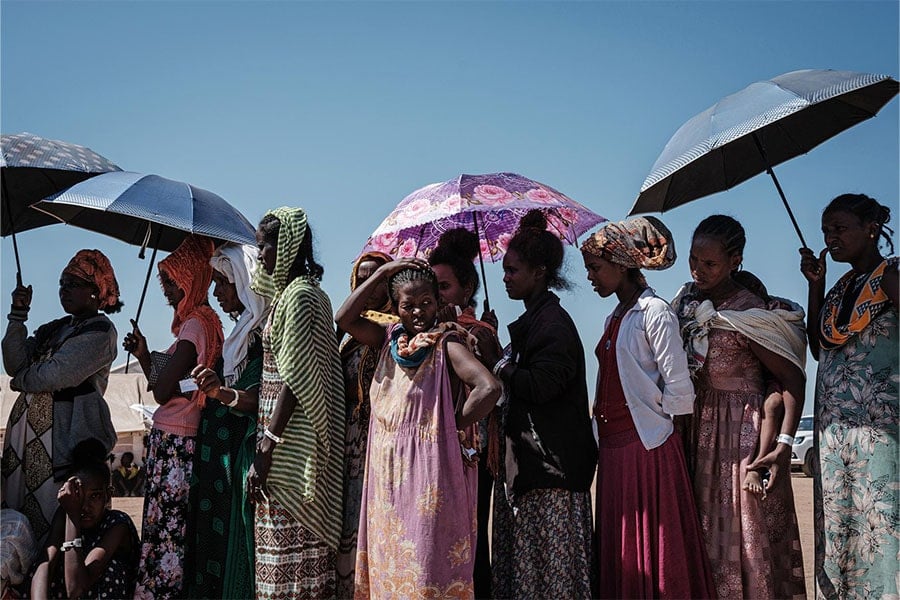
On November 4, 2020 tensions in the Ethiopian region of Tigray erupted when Ethiopian Prime Minister mobilised Ethiopian forces, ordering them into Mekelle - Tigray's capital city. Almost 10 months on, the situation in Tigray has only escalated; with widespread accounts of man-made famine, weaponised rape, ethnic cleansing and human rights violations flowing out from the region. It's for this reason that there's been a growing tide of voices across social media and from members of the Tigrayan diaspora urging world leaders to recognise the humanitarian crisis as genocide.
As we piece together the atrocities taking place in Tigray, it's imperative that we educate ourselves on the critical events leading up to, and following the offensive launched on Mekelle. Below we've outlined what you need to know about the crisis in Tigray so far.
What should I know about Tigray?
Tigray is a region in the northernmost part of Ethiopia that shares a border with Eritrea and Sudan. Making up 6% of Ethiopia's total population, Tigrayans are the third largest ethnic group in the country, behind the Oromo and the Amhara people. Historically, Tigrayans have had a weighty influence on Ethiopian politics as you'll soon come to understand below.
From a political perspective, there's a great concern that conflict in the region will further exacerbate ethnic tensions which could ultimately result in certain ethnic regions breaking away from Ethiopia. Also as Africa's second-most populous country (Nigeria is first), Ethiopia is pivotal to stability in the Horn of Africa. Yet, seeing as Eritrea's own military forces have joined the conflict and Sudan is playing host to tens of thousands of refugees, peace in the region may no longer be possible.
Who are the Tigray People’s Liberation Front?
Originally formed in 1975, the Tigray People’s Liberation Front was established in order to bring about Tigrayan self-determination. Throughout the 1970s and 80s, the TPLF fought against the then Derg regime, a military junta, and finally seized control in 1991 under the banner of the Ethiopian People’s Revolutionary Democratic Front - a coalition of four ethnic Ethiopian rebel groups. Since 1991 and under the EPRDF party, the Tigray People’s Liberation Front had been a dominant player in the new coalition. How this works is that the coalition gave autonomy to Ethiopia's ethnic regions but maintained a tight grip over the central government. While this allowed the coalition to lead for nearly three decades, critics accused the government of suppressing political opposition and therefore democratic process.
That is, until Ethiopian Prime Minister Abiy Ahmed came to power in 2018 as the leader of the EPRDF. A year after his new appointment, Abiy Ahmed dissolved the coalition and in its place formed the Prosperity Party in the hope of casting aside the country's history of ethnic divisiveness. He encouraged the TPLF to join but they refused, believing Ahmed wanted to centralise the governments power and destabilise Ethiopia's federal system. So the TPLF retreated to their power base in Tigray instead. During this period Ahmed made efforts to resolve a long-standing territorial conflict between Ethiopia and its neighbour Eritrea - for which he was awarded a Nobel Peace Prize in 2019 - a partnership that would prove essential to the Ethiopian government in the coming months.
Around this time Ahmed also removed key Tigrayan government leaders accused of corruption and suppression and promised to hold Ethiopia's first democratic elections last July. However, the elections were postponed allegedly due to the Covid-19 pandemic. Following the announcement delaying the vote, the TPLF denounced the move as unconstitutional, claiming Prime Minister Ahmed was not within his right to do so. As a result, the TPLF held their own regional elections in September, an unprecedented act of defiance, and secured a decisive win. Ahmed's government immediately declared the TPLF's elections illegal and tensions spiked to an all new boiling point.
What was the catalyst for the crisis?
On November 4, 2020, Ethiopian Prime Minister Abiy Ahmed mobilised the Ethiopian National Defense Force from Addis Ababa, launching an offensive on Mekelle - the capital city of Tigray. His decision came after the TPLF seized a key Ethiopian military base in Sero, sparking the devastating humanitarian crisis in Tigray.
Although, it's important to note that Tigrayan leaders have said their move was in reaction to Ethiopian lawmakers cutting funding to the region and Prime Minister Abiy encouraging the central government to sever ties with regional leaders.
How bad is the humanitarian crisis in Tigray?
A staggering 2 million people, of Tigray's 6 million-large population have fled their homes since the invasion ordered by Prime Minister Ahmed on November 4 reports BBC. Many of these people have ended up in refugee camps in Sudan.
At this point, there have been countless stories flowing out from Ethiopia that describe harrowing instances of human rights violations from both Ethiopian and Tigrayan forces; although the United Nations human rights office has noted the most widespread atrocities have been committed against Tigrayans.
In August, UN Chief UN António Guterres told journalists that he is gravely concerned about the “unspeakable violence” being inflicted upon women and children in Tigray. And a joint investigation by the OHCHR and the Ethiopian Human Rights Commission revealed reports of "sexual and gender-based violence including gang rapes, sexualised torture and ethnically targeted sexual violence." These accounts have been corroborated with members of the Tigrayan diaspora who have family currently living in Tigray through this chapter of unspeakable terror.
The United Nations have also expressed frustration at their inability to access areas outside of the main cities. Especially as there is currently a man-made famine sweeping Tigray following a "humanitarian aid blockade" imposed by the Ethiopian government in June - with the UN calling it "the world's worst hunger crisis in over a decade". Since electricity and telecommunications have been cut (along with banking and internet services) in Tigray it's been difficult to ascertain the exact number of casualties from the crisis. Although, researchers at Belgium's University of Ghent have alleged there have been at least 10,000 reported deaths and 230 massacres against Tigrayans, with internal documents and eyewitness accounts revealing the first deaths from starvation. It's for this reason that there's a growing call to label the crisis in Tigray as genocide.
What will happen next?
With so much information take in, it can feel incredibly overwhelming trying to piece together what help and support can be given to the people of Tigray.
Last week US President Joe Biden announced sanctions for any party continuing to prolong the crisis in Tigray. This includes the Ethiopian government, the Eritrean government, as well as TPLF forces. By all accounts the Ethiopian army is backed by Eritrean forces; however the BBC reported that both governments are denying the presence of Eritrean soldiers in Tigray. Biden also agreed with the UN African Union that “there is no military solution to this crisis”.
As is the case for Afghanistan, the situation in Tigray continues to unfold as we speak. While we collate resources and ways to help, it's important that you stay up to date with the news coming out of the region and raise awareness among your circles, urging people to bear witness to this crisis and the plight of those in Ethiopia.
Images: Pinterest



